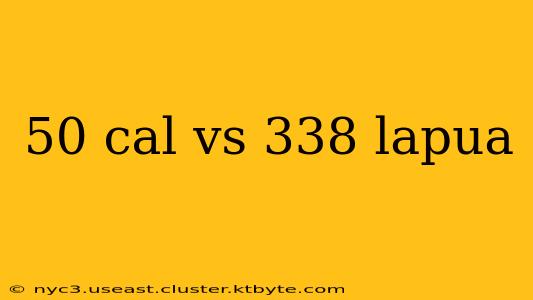The .50 BMG and .338 Lapua Magnum are both heavy-hitting cartridges renowned for their long-range capabilities, but they cater to different needs and priorities. This in-depth comparison will delve into the key differences between these two powerful calibers, helping you determine which best suits your specific requirements.
Caliber Overview: Power and Purpose
The .50 BMG (Browning Machine Gun), developed in the early 20th century, is a truly massive round, designed for anti-materiel and long-range sniping applications. Its immense power and stopping force are unmatched, making it effective against lightly armored vehicles and personnel at extreme ranges.
The .338 Lapua Magnum, while still exceptionally powerful, represents a more modern approach to long-range precision. Developed in the late 20th century, it prioritizes accuracy and manageable recoil over sheer brute force. This makes it a favorite among precision rifle shooters and military snipers.
Key Differences: A Detailed Breakdown
| Feature | .50 BMG | .338 Lapua Magnum |
|---|---|---|
| Caliber | .50 inch (12.7mm) | .338 inch (8.6mm) |
| Bullet Weight | Typically 660-800 grains (42-52g) | Typically 250-300 grains (16-19g) |
| Muzzle Energy | Extremely high, often exceeding 15,000 ft-lbs | Very high, typically 4,000-5,000 ft-lbs |
| Recoil | Extremely high, requires significant bracing | High, but significantly less than .50 BMG |
| Accuracy | Excellent at shorter ranges, decreases at extreme ranges | Exceptional accuracy at extreme ranges |
| Effective Range | Extremely long, up to 2 miles or more | Exceptionally long, exceeding 1.5 miles |
| Weapon Systems | Primarily used in heavy machine guns and large-bore sniper rifles | Used in a variety of bolt-action sniper rifles |
| Cost per round | Significantly higher | Higher than most calibers, but less than .50 BMG |
| Weight | Heavier overall ammunition weight | Lighter overall ammunition weight |
Recoil Management: A Significant Factor
The .50 BMG's substantial recoil demands significant physical strength and proper shooting technique. Even experienced shooters can find it challenging to maintain accuracy during sustained fire. The .338 Lapua, while still possessing considerable recoil, is considerably more manageable, allowing for longer shooting sessions with improved precision.
Accuracy and Range: Precision vs. Power
Both calibers offer exceptional long-range performance. The .50 BMG's massive power allows it to maintain effective range against larger targets at extreme distances. However, the .338 Lapua Magnum generally boasts superior accuracy, making it better suited for precise shots at distant, smaller targets. This difference is largely attributed to the smaller, more aerodynamic bullet.
Practical Applications: The Right Tool for the Job
The .50 BMG remains a powerful tool for engaging heavily armored targets and providing suppressive fire. It excels in situations where overwhelming firepower is needed. The .338 Lapua Magnum, on the other hand, is the preferred choice for long-range precision shooting where pinpoint accuracy and manageable recoil are critical, such as military sniping and competitive long-range shooting.
Conclusion: Choosing the Right Caliber
The best choice between the .50 BMG and .338 Lapua Magnum ultimately depends on your specific needs and priorities. If you require maximum stopping power and can handle significant recoil, the .50 BMG is a formidable option. If accuracy, manageable recoil, and extended shooting sessions are your priorities, the .338 Lapua Magnum provides superior performance in those areas. Careful consideration of your intended applications is essential in making the right decision.

